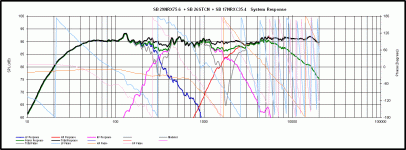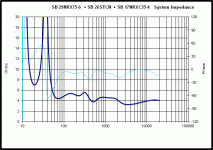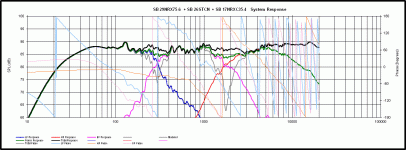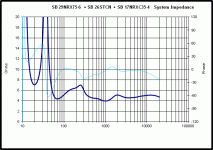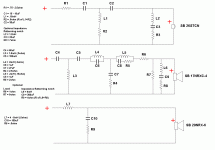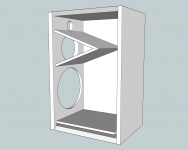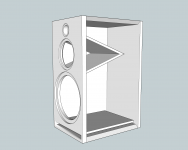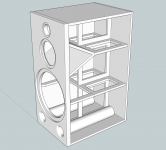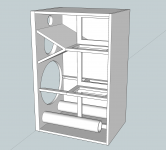Hi,
Bass / mid active and mid / treble minimalist passive is a fine idea,
though you still have to optimise the mid/treble behaviour.
Cost is the issue and what your really trying to build, BFB ?
Bang for buck is about the skillful art of least compromise
on a restricted budget and TBH my main interest in hifi,
which skews my opinion of many NHB approaches.
rgds, sreten.
Bass / mid active and mid / treble minimalist passive is a fine idea,
though you still have to optimise the mid/treble behaviour.
Cost is the issue and what your really trying to build, BFB ?
Bang for buck is about the skillful art of least compromise
on a restricted budget and TBH my main interest in hifi,
which skews my opinion of many NHB approaches.
rgds, sreten.
Here is a thought. I have been thinking about the possibility of going active. I’m aware that this would increase the cost substantially, but I have discussed it with my friend and he is open to the idea. If doing this I thought about using 2 x miniDSP PWR-ICE 125 plate amps and make a 2-way active xo between woofer and mid+tweeter. Here are a few reasons why I think this would be a good idea.
It's not a bad idea but I'm not sure that the above unit is the best way to implement it.
[*]It would give me much more flexibility with regards to XO, filtering and EQ. This would come in handy considering the unusual speaker placement.
Perhaps not as much flexibility as you may think. It will take up more volume inside each speaker and when you attach the cords to the back of the unit, this will take up even more valuable space between the back of the speaker and the shelving unit. Also, the dsp unit will handle the LP on the woofer and the HP on the mid but you will still need a passive LP on the mid and a passive HP on the tweeter.
[*]No padding down is needed to align the driver sensitivities, so there will be no “wasting power”.
I don't know where you're getting the idea that you are going to be loosing any significant amount of power with these drivers in this set-up in terms of padding. Everyone seems worried that the woofer is going to be too loud from all the boundary gain. Right now in my sims with about 8dB of boost, that leaves you with no padding on the SB17NRXC and sensitivity of 90dB. You only need about 10W to hit 100dB at 1m. If I have over estimated room gain by a dB or 2 then you'll still be at about 88dB overall and that is still exemplory.
[*]My friend would like to be able to move his speakers to another location in the future without having to re-design a new passive xo. With a built-in DSP it would be simple to set up the speakers in another room, do in-room measurements, and change the filters accordingly.
In this case, ignore what I had written previously about cabinet wall thickness - you are going to want at least 20mm walls well braced so again that eats a little more into your net available internal volume.
Also, moving the speaker from its present location to say up on a stand with the tweeter at ear level is going to play havoc with both the woofer/mid xo as well as the mid/tweeter xo. The diffraction ripples are all going to be present in the mid and tweeter while the baffle step loss will be present with the woofer. You have flexibility with one but not the other and some changes will need to be made to the mid/tweeter xo.
[*]We would save money not having buy expensive parts in the passive xo.
This one kind of makes me laugh. The woofer/mid xo does usually have the more expensive components but you're talking about spending $550 for the 2 dsp units to save maybe $100 in xo parts. Mind you, you do get new amps too.
[*]Although my friend’s current amp will work fine for e.g. the 3-way SB speakers (which have been discussed as a potential build), the speakers have a higher power handling and would be able to play louder with less distortion with a higher powered amp.
The SB17NRXC suggests max power at 60W. With 90dB sensitivity, you'll get 105dB at 1m with about 32W. Add in some headroom if you really want to be able to play it that loud and a more powerful amp isn't a bad idea. More so I think to drive the woofer which has some pretty high impedance peaks and a fairly low impedance phase angle.
[*]My friend only has one source, which is a Sonos Connect with digital output and volume control. This means that there is not really a need for an integrated stereo amp with input selector. Also, one of his friends may be interested in purchasing his old amp and speakers.
Make sure that you have remote control of the volume with any of these units and that it'll work if the dsp unit is on the back of a speaker that is stuffed inside another cabinet.
Personally, if I was going active in this case I would make it all active and get rid of the passive xo's all together. That will really give you the flexibility that you need if you want to start moving it around into very different listening locations. You will of course need 2 new stereo amps to make that happen though. Something like this for eg. - Behringer DCX2496 Ultradrive Pro Digital Crossover | 248-669.
But for your purposes, I still think that you can get the flexibility and SQ you are after with passive xo's and a good enough eq, perhaps something like this - Behringer FBQ1502 Ultragraph Pro Dual 15-Band EQ | 248-726 or this - Behringer FBQ3102 Ultragraph Pro Dual 31-Band EQ | 248-724.
And if you really wanted to spend more money and go for better SQ, I'd also be inclined to seriously think about stepping up the quality of the drivers, like these for eg:
The Madisound Speaker Store
The Madisound Speaker Store
One obvious problem is that you cannot normally use plate amplifiers with built in speakers because you need to get rid of the heat.What are your thoughts on this idea?
Active crossovers still require you to sort out the design beforehand. For example, a strong bass boost within the passband of the woofer or between the woofer and midrange will lead to a significantly different choice of drivers. Adding the requirement to also to work in another location is likely to compromise the performance in both. Juggling all this stuff should be fun or else DIY is not going to be cost effective.
Perhaps not as much flexibility as you may think. It will take up more volume inside each speaker and when you attach the cords to the back of the unit, this will take up even more valuable space between the back of the speaker and the shelving unit. Also, the dsp unit will handle the LP on the woofer and the HP on the mid but you will still need a passive LP on the mid and a passive HP on the tweeter.
I know it’s not a perfect solution and it won’t give me complete flexibility, but it will give some flexibility where I most need it, namely in the bass frequency as well as xo between woofer and mid. Regarding the volume taken up by the plate amp, this will be very limited inside cabinet, something like 0.5L. Of course room behind the plate amp, this is of course needed and will limit the depth of the cabinet. I will have to talk with the interior designer regarding the exact measurements of the bookshelf.
I don't know where you're getting the idea that you are going to be loosing any significant amount of power with these drivers in this set-up in terms of padding. Everyone seems worried that the woofer is going to be too loud from all the boundary gain. Right now in my sims with about 8dB of boost, that leaves you with no padding on the SB17NRXC and sensitivity of 90dB. You only need about 10W to hit 100dB at 1m. If I have over estimated room gain by a dB or 2 then you'll still be at about 88dB overall and that is still exemplory.
Perhaps I won’t need much padding down in the passive xo (if anything at all), but I can’t be sure until the speakers have been built and placed in the bookshelf, and then if padding down is needed it would be a more complicated task compared to doing it actively in the DSP software.
In this case, ignore what I had written previously about cabinet wall thickness - you are going to want at least 20mm walls well braced so again that eats a little more into your net available internal volume.
I was never going to build the speakers to be dependent on the bookshelf. I was planing on using 19mm MDF for cabinet walls and bracing, perhaps 22 or 25mm for the baffle. Regarding internal volume of the speaker, I don’t think neither the wall thickness nor the plate amp will take up any significant volume from the enclosure.
Also, moving the speaker from its present location to say up on a stand with the tweeter at ear level is going to play havoc with both the woofer/mid xo as well as the mid/tweeter xo. The diffraction ripples are all going to be present in the mid and tweeter while the baffle step loss will be present with the woofer. You have flexibility with one but not the other and some changes will need to be made to the mid/tweeter xo.
Knowing my friend he will never be in a situation where the speakers will be permanently placed on stands away from the walls. When I say a different location it will most likely be in a bookshelf again, but the DSP may still be useful to adjust for for different room size, distance to wall and floor, etc.
This one kind of makes me laugh. The woofer/mid xo does usually have the more expensive components but you're talking about spending $550 for the 2 dsp units to save maybe $100 in xo parts. Mind you, you do get new amps too.
Laugh all you want but that is about $450 for 4 x 120W Danish engineered state-of-the-art class-d amps with DSP. I don’t think that’s expensive.
The SB17NRXC suggests max power at 60W. With 90dB sensitivity, you'll get 105dB at 1m with about 32W. Add in some headroom if you really want to be able to play it that loud and a more powerful amp isn't a bad idea. More so I think to drive the woofer which has some pretty high impedance peaks and a fairly low impedance phase angle.
So going active with 2 x 120W (4ohm) for each speaker should be sufficient for the SB 3-way, right? Also, with an active XO I guess I could also reconsider the size and nom impedance of the midrange?
Make sure that you have remote control of the volume with any of these units and that it'll work if the dsp unit is on the back of a speaker that is stuffed inside another cabinet.
I have been looking into this and there are plenty of people out there who use the Sonos Connect as a preamp, so the plate amp will be in a fixed volume setting (max volume) and then the volume will be controlled by the Sonos.
Personally, if I was going active in this case I would make it all active and get rid of the passive xo's all together. That will really give you the flexibility that you need if you want to start moving it around into very different listening locations. You will of course need 2 new stereo amps to make that happen though. Something like this for eg. - Behringer DCX2496 Ultradrive Pro Digital Crossover | 248-669
This is of course the best way to go, but on top of being an expensive solution, a DCX2496 + 3 x stereo amps + 3 cables to each speaker won’t be a very simple and elegant solution compared to the plate amps I suggested. I have looked into 3-way plate amps, but everything I’ve found is very expensive.
One obvious problem is that you cannot normally use plate amplifiers with built in speakers because you need to get rid of the heat.
Since the speakers will be ported, the plate amp shouldn’t need a separate enclosure, which will mean that there should be plenty of air movement inside the speaker. Also, the back of the speaker won’t be completely sealed off, as there will be air gaps around the speakers. Furthermore, being class-d amps they will generate much less heat compared to traditional solidstate.
Active crossovers still require you to sort out the design beforehand. For example, a strong bass boost within the passband of the woofer or between the woofer and midrange will lead to a significantly different choice of drivers. Adding the requirement to also to work in another location is likely to compromise the performance in both. Juggling all this stuff should be fun or else DIY is not going to be cost effective.
You are right. The choice of drivers is still critical, but this is what we have been discussing for the many lasts post. I think the SB 10”+5/6”+1” suggested by jReave is a good starting point, which shouldn’t need too much DSP tweaking to sound good.
Hmmm... If you are confident it is safe then it is your project.Since the speakers will be ported, the plate amp shouldn’t need a separate enclosure, which will mean that there should be plenty of air movement inside the speaker. Also, the back of the speaker won’t be completely sealed off, as there will be air gaps around the speakers. Furthermore, being class-d amps they will generate much less heat compared to traditional solidstate.
There has been discussion but little of it seems to have been based on design information. For example, on what are you basing the statement "which shouldn’t need too much DSP tweaking to sound good"? This looks rather faith based to me but again it is your project.You are right. The choice of drivers is still critical, but this is what we have been discussing for the many lasts post. I think the SB 10”+5/6”+1” suggested by jReave is a good starting point, which shouldn’t need too much DSP tweaking to sound good.
Hmmm... If you are confident it is safe then it is your project.
I’m not confident about this actually. I was looking at other plate amp speaker builds and they all have separate enclosure for the plate amp. I guess that if you don’t put the plate amp in its own enclosure the connections that aren’t airtight will start to whistle when the volume is turned up. And if I seal off the plate amp, it can only get rid of the heat from the back, and since it’s inside a bookshelf I guess that would be a problem, like you said.
There has been discussion but little of it seems to have been based on design information. For example, on what are you basing the statement "which shouldn’t need too much DSP tweaking to sound good"? This looks rather faith based to me but again it is your project.
You are right that this is somewhat faith based, but then again, if I had all the answers myself, I wouldn’t need to ask for help on a forum like this. This thread is 9 pages long now and I feel more confused about the project than when I started

soren, first off - sorry - I meant no insult with my "laughing" comment if that is the way you took it. It was just sort of the way you put it that made me chuckle a little. I knew you'd be getting a lot more than just the active xo's with what you were thinking off.
Perhaps it might help to take a small step back and understand that the advice you get on this site and others like it is usually going to be coming from people who are into audio perfection. So I often find that when a more casual type listener comes here looking for good to very good sound but not something for super critical listening (and I think this is how you have described your friend), it's often hard for the experts to drop their standards.
Take the info I posted earlier about cavity resonances for eg. Definitely important to the audiophile but just forget about it for the casual listener. All kinds of people take a normal speaker and put it into some type of bookshelf and think it sounds just fine. Maybe even better. They are not aghast at the little bit of bass boost they are getting nor any likely suck-outs in the midbass. Likewise, all kinds of people take a normal speaker and put it on the floor, perhaps close to both the side and back walls, and again, think that it sounds just fine. Again many people might think it sounds even better (more bass, mmmm.... ).
).
My point being that for your purposes, for a casual listener, they are not going to care that much if the frequency response is or isn't perfectly flat to within +/- .5dB. Flat +/- 3dB without any nasty peaking will probably be just fine. Nor are you going to worry much about soundstaging nor imaging nor perfect phase matching to name a few others. You have some leeway here in other words.
But you do need to get the basics right for your situation. Here's how I would summarize your priorities:
- high value, low distortion, low resonant drivers with good off-axis responses
- size constraint of about 60L
- F3 =~ 25Hz, so a FR from 25 -20,000Hz
- SPL =~ 100 - 105dB @ 1m (?)
- sensitivity in the 88 - 90dB range, which means about 16 - 50W of required amp power not including headroom for those SPL's
- placement flexibility, although if your buddy is going to just move the speakers from 1 cabinet to another, that's probably not going to create much difference
- a well designed xo that takes advantage of the drivers' strengths and nullifies their weakness and that works for the location (see below for more detail)
- frequency shaping flexibility, specifically for the woofer level due to potential boundary gain and for the HF level due to off-axis losses, but don't over-think this. Padding down the mid & tweeter is about as easy as it gets in a passive xo - just add some resistors until it sounds right to your ears. And even just fiddling with the treble control can adjust for the HF losses for a casual listener.
You've pretty much got all of these covered except for that darned last one. And it seems like you've got 2 choices:
1 - Trust the simulations, don't worry about perfection and go with a passive xo. Add an eq if you think it's necessary. Upgrade amplifiers if you think you need more power. Do it in stages so you don't waste money. There's a possibility you could bi-amp here with the woofer on a new amp and the mid and tweeter staying on the old one but I'm not an expert in this and am not sure how the master volume would be controlled with your components.
2 - Go active, partially or fully. Include new amplifiers on your shopping list. In this case, if you move speaker locations (in-shelf to in-shelf) the same passive TM xo could be fine for both locations. Also, since the drivers will be on separate amps, you don't have to have such a sensitive mid so you could switch to the SB15NRXC-4 which needs less internal volume giving you a little more space to work with.
Either way you go, with the SB drivers the xo has to do the following:
- sum well vertically and horizontally off-axis: PCD allows you to do this easily, so does choosing a low enough TM xo point so that off-axis response stays strong through the overlap, about 2000Hz
- choose a LF xo point that corresponds to where the boundary reinforcement starts to diminish: 250 - 300Hz
- for the woofer, get the 3kHz resonance down low with either a steep slope or a tanking capacitor
- for the mid, use an impedance flattening notch on the high impedance spike and again suppress the HF resonances with a steep slope and 1 or 2 tanking filters
- if possible, run the tweeter a little hot or rising on the top end to make up for any off-axis losses above about 5-6kHz or so
I've posted the FR of what I've come up with for a passive xo previously. Let me know if you want me to post the schematic.
Hope that helps. Sorry, I know...... another long post.
Perhaps it might help to take a small step back and understand that the advice you get on this site and others like it is usually going to be coming from people who are into audio perfection. So I often find that when a more casual type listener comes here looking for good to very good sound but not something for super critical listening (and I think this is how you have described your friend), it's often hard for the experts to drop their standards.
Take the info I posted earlier about cavity resonances for eg. Definitely important to the audiophile but just forget about it for the casual listener. All kinds of people take a normal speaker and put it into some type of bookshelf and think it sounds just fine. Maybe even better. They are not aghast at the little bit of bass boost they are getting nor any likely suck-outs in the midbass. Likewise, all kinds of people take a normal speaker and put it on the floor, perhaps close to both the side and back walls, and again, think that it sounds just fine. Again many people might think it sounds even better (more bass, mmmm....
My point being that for your purposes, for a casual listener, they are not going to care that much if the frequency response is or isn't perfectly flat to within +/- .5dB. Flat +/- 3dB without any nasty peaking will probably be just fine. Nor are you going to worry much about soundstaging nor imaging nor perfect phase matching to name a few others. You have some leeway here in other words.
But you do need to get the basics right for your situation. Here's how I would summarize your priorities:
- high value, low distortion, low resonant drivers with good off-axis responses
- size constraint of about 60L
- F3 =~ 25Hz, so a FR from 25 -20,000Hz
- SPL =~ 100 - 105dB @ 1m (?)
- sensitivity in the 88 - 90dB range, which means about 16 - 50W of required amp power not including headroom for those SPL's
- placement flexibility, although if your buddy is going to just move the speakers from 1 cabinet to another, that's probably not going to create much difference
- a well designed xo that takes advantage of the drivers' strengths and nullifies their weakness and that works for the location (see below for more detail)
- frequency shaping flexibility, specifically for the woofer level due to potential boundary gain and for the HF level due to off-axis losses, but don't over-think this. Padding down the mid & tweeter is about as easy as it gets in a passive xo - just add some resistors until it sounds right to your ears. And even just fiddling with the treble control can adjust for the HF losses for a casual listener.
You've pretty much got all of these covered except for that darned last one. And it seems like you've got 2 choices:
1 - Trust the simulations, don't worry about perfection and go with a passive xo. Add an eq if you think it's necessary. Upgrade amplifiers if you think you need more power. Do it in stages so you don't waste money. There's a possibility you could bi-amp here with the woofer on a new amp and the mid and tweeter staying on the old one but I'm not an expert in this and am not sure how the master volume would be controlled with your components.
2 - Go active, partially or fully. Include new amplifiers on your shopping list. In this case, if you move speaker locations (in-shelf to in-shelf) the same passive TM xo could be fine for both locations. Also, since the drivers will be on separate amps, you don't have to have such a sensitive mid so you could switch to the SB15NRXC-4 which needs less internal volume giving you a little more space to work with.
Either way you go, with the SB drivers the xo has to do the following:
- sum well vertically and horizontally off-axis: PCD allows you to do this easily, so does choosing a low enough TM xo point so that off-axis response stays strong through the overlap, about 2000Hz
- choose a LF xo point that corresponds to where the boundary reinforcement starts to diminish: 250 - 300Hz
- for the woofer, get the 3kHz resonance down low with either a steep slope or a tanking capacitor
- for the mid, use an impedance flattening notch on the high impedance spike and again suppress the HF resonances with a steep slope and 1 or 2 tanking filters
- if possible, run the tweeter a little hot or rising on the top end to make up for any off-axis losses above about 5-6kHz or so
I've posted the FR of what I've come up with for a passive xo previously. Let me know if you want me to post the schematic.
Hope that helps. Sorry, I know...... another long post.
soren, first off - sorry - I meant no insult with my "laughing" comment if that is the way you took it. It was just sort of the way you put it that made me chuckle a little. I knew you'd be getting a lot more than just the active xo's with what you were thinking off.
No offense taken. I think I misunderstood
Perhaps it might help to take a small step back and understand that the advice you get on this site and others like it is usually going to be coming from people who are into audio perfection. So I often find that when a more casual type listener comes here looking for good to very good sound but not something for super critical listening (and I think this is how you have described your friend), it's often hard for the experts to drop their standards.
Take the info I posted earlier about cavity resonances for eg. Definitely important to the audiophile but just forget about it for the casual listener. All kinds of people take a normal speaker and put it into some type of bookshelf and think it sounds just fine. Maybe even better. They are not aghast at the little bit of bass boost they are getting nor any likely suck-outs in the midbass. Likewise, all kinds of people take a normal speaker and put it on the floor, perhaps close to both the side and back walls, and again, think that it sounds just fine. Again many people might think it sounds even better (more bass, mmmm....).
My point being that for your purposes, for a casual listener, they are not going to care that much if the frequency response is or isn't perfectly flat to within +/- .5dB. Flat +/- 3dB without any nasty peaking will probably be just fine. Nor are you going to worry much about soundstaging nor imaging nor perfect phase matching to name a few others. You have some leeway here in other words.
I think that’s a very good point!
But you do need to get the basics right for your situation. Here's how I would summarize your priorities:
- high value, low distortion, low resonant drivers with good off-axis responses
- size constraint of about 60L
- F3 =~ 25Hz, so a FR from 25 -20,000Hz
- SPL =~ 100 - 105dB @ 1m (?)
- sensitivity in the 88 - 90dB range, which means about 16 - 50W of required amp power not including headroom for those SPL's
- placement flexibility, although if your buddy is going to just move the speakers from 1 cabinet to another, that's probably not going to create much difference
- a well designed xo that takes advantage of the drivers' strengths and nullifies their weakness and that works for the location (see below for more detail)
- frequency shaping flexibility, specifically for the woofer level due to potential boundary gain and for the HF level due to off-axis losses, but don't over-think this. Padding down the mid & tweeter is about as easy as it gets in a passive xo - just add some resistors until it sounds right to your ears. And even just fiddling with the treble control can adjust for the HF losses for a casual listener.
Thanks for that. This pretty much summarizes the objectives for the project.
You've pretty much got all of these covered except for that darned last one. And it seems like you've got 2 choices:
1 - Trust the simulations, don't worry about perfection and go with a passive xo. Add an eq if you think it's necessary. Upgrade amplifiers if you think you need more power. Do it in stages so you don't waste money. There's a possibility you could bi-amp here with the woofer on a new amp and the mid and tweeter staying on the old one but I'm not an expert in this and am not sure how the master volume would be controlled with your components.
Yes, I think I will most likely end up going passive to begin with.
And that's an interesting point about the possibility of bi-amping later on in case my friend needs more SPL. I think it would be pretty straightforward to add an extra stereo amp for the woofers and then adjust the volumes accordingly. Master volume would be controlled by the Sonos Connect pre-amp.
2 - Go active, partially or fully. Include new amplifiers on your shopping list. In this case, if you move speaker locations (in-shelf to in-shelf) the same passive TM xo could be fine for both locations. Also, since the drivers will be on separate amps, you don't have to have such a sensitive mid so you could switch to the SB15NRXC-4 which needs less internal volume giving you a little more space to work with.
I still like the idea of going active, but due to the issues of heat dissipation inside the bookshelf, I think plate amps are a no go here. It would probably be wiser to use a DCX2496 as you mentioned (fully active) or a miniDSP 2x4 (partially active), and then add some kind of multi-channel power amplifier. Are you aware of any good value multi-channel amps? Is it worth looking into PA amps? Are these any good for home stereos?
Either way you go, with the SB drivers the xo has to do the following:
- sum well vertically and horizontally off-axis: PCD allows you to do this easily, so does choosing a low enough TM xo point so that off-axis response stays strong through the overlap, about 2000Hz
- choose a LF xo point that corresponds to where the boundary reinforcement starts to diminish: 250 - 300Hz
- for the woofer, get the 3kHz resonance down low with either a steep slope or a tanking capacitor
- for the mid, use an impedance flattening notch on the high impedance spike and again suppress the HF resonances with a steep slope and 1 or 2 tanking filters
- if possible, run the tweeter a little hot or rising on the top end to make up for any off-axis losses above about 5-6kHz or so
This all sounds good to me
I've posted the FR of what I've come up with for a passive xo previously. Let me know if you want me to post the schematic.
That would be a great help if I could see your suggestion for the xo schematic. By the way, what .frd .zma files did you use to make the FR / xo? Did you trace them from the manufacturer's spec sheets?
Hope that helps. Sorry, I know...... another long post.
That was really helpful. Thanks a lot!
[...] and then add some kind of multi-channel power amplifier. Are you aware of any good value multi-channel amps? Is it worth looking into PA amps? Are these any good for home stereos?
E.g. something like this 8 x 50W power amp, where two sets of channels could be bridged to give extra power for the woofers.
There are 2 sets of charts below. The 1st set uses the boundary gain info I have previously posted, so there is about a 7-8dB increase above typical 6dB baffle step loss. The 2nd set I just wanted to include to show how to handle slightly less boundary gain - in this case about 2dB less. I included the impedance results as well.
Reading the summed FR graphs, black is the summed response 25cm above the tweeter axis (about the typical seated listening height), green is the power response (the total sum of all directional axises, correct to be dropping in the HF), grey is the reverse nulls showing very good phase alignment and the lighter lines are the actual phases for each driver (you want them to be closely aligned in the xo regions). Impedance is above 4ohm except where it dips down to about 3ohm around 2kHz which is fine for 4ohm amps. Impedance phase drops down to about -60* at about 45Hz but the impedance remains higher here and again shouldn't be a problem for a high current 4ohm amp.
The woofer gets a simple 2nd order electrical with an extra shaping resistor. The tweeter is 3rd order electrical also with an added shaping resistor. The tweeter's impedance peak isn't very high but the xo is still closer to it than I would like, so an optional circuit would be an impedance flattening notch, L2-C3-R3, but I suspect that it won't be necessary.
The mid looks a little more complicated but isn't too tricky. First, the impedance flattening notch L6-C9-R8 is again optional. The impedance spike on the 17NRXC is actually quite high and will affect the LF roll-off unless addressed, but the big capacitor I have on the 3rd order HP (C5) is doing a good job of taking care of that. I included the LCR filter just to give you an idea of what this circuit is actually going to look like (rather large values). The L-pad is there to bring the mids down to the level in the 2nd FR graph, about 88dB. This works a little better to maintain the overall shape of the mid's response than just a single resistor.
The HP and LP are both 3rd order electrical. I've gone to the slightly unusual step here of using 2 extra capacitors to strongly suppress all the HF output of the mid which is actually fairly high and unwanted (that's C6 and C8 in parallel with the inductors - they "tank" the response at very specific higher frequencies, usually used to target cone resonances).
I'm about 90% confident that the 1st xo will handle all the extra boundary gain that's happening in your setup. In fact I think that there might be just a little too much. In that case, we want to drop the mid and tweeter level a bit like the 2nd xo does. Success may lie anywhere between these 2 conditions. I think you can let you and your friend's ears be the guide here. There will be only 4 things to change:
- R1 for the tweeter level
- R6 & R7 for the mid level
- L7 on the woofer for the "knee" between 100 and 200Hz
- C1 on the tweeter for the "knee" around 2kHz
I can go into more detail here for you if you want to go this way.
For frd files, yes I traced SB's FR graphs using SPLTrace after checking to see that they compared favorably to Zaph's measurements, spliced on the LF box responses and added the diffraction + boundary effects. Response Modeler can put all that together for you although I use something different. I use RM to sim the boxed LF impedance response but then make sure that the rest of it matches the original (traced) by importing it into RM and modifying it if necessary. Extract minimum phases and then enter into PCD. Something else I can do that may help you out is to send you a copy of the PCD Excel workbook with all the files already included. I think you should be able to just open it up and start playing with values. pm me your email address if that seems like a good idea to you.
Sorry, I've never looked at any multiple amps besides for home theater. Can't help you there.
Reading the summed FR graphs, black is the summed response 25cm above the tweeter axis (about the typical seated listening height), green is the power response (the total sum of all directional axises, correct to be dropping in the HF), grey is the reverse nulls showing very good phase alignment and the lighter lines are the actual phases for each driver (you want them to be closely aligned in the xo regions). Impedance is above 4ohm except where it dips down to about 3ohm around 2kHz which is fine for 4ohm amps. Impedance phase drops down to about -60* at about 45Hz but the impedance remains higher here and again shouldn't be a problem for a high current 4ohm amp.
The woofer gets a simple 2nd order electrical with an extra shaping resistor. The tweeter is 3rd order electrical also with an added shaping resistor. The tweeter's impedance peak isn't very high but the xo is still closer to it than I would like, so an optional circuit would be an impedance flattening notch, L2-C3-R3, but I suspect that it won't be necessary.
The mid looks a little more complicated but isn't too tricky. First, the impedance flattening notch L6-C9-R8 is again optional. The impedance spike on the 17NRXC is actually quite high and will affect the LF roll-off unless addressed, but the big capacitor I have on the 3rd order HP (C5) is doing a good job of taking care of that. I included the LCR filter just to give you an idea of what this circuit is actually going to look like (rather large values). The L-pad is there to bring the mids down to the level in the 2nd FR graph, about 88dB. This works a little better to maintain the overall shape of the mid's response than just a single resistor.
The HP and LP are both 3rd order electrical. I've gone to the slightly unusual step here of using 2 extra capacitors to strongly suppress all the HF output of the mid which is actually fairly high and unwanted (that's C6 and C8 in parallel with the inductors - they "tank" the response at very specific higher frequencies, usually used to target cone resonances).
I'm about 90% confident that the 1st xo will handle all the extra boundary gain that's happening in your setup. In fact I think that there might be just a little too much. In that case, we want to drop the mid and tweeter level a bit like the 2nd xo does. Success may lie anywhere between these 2 conditions. I think you can let you and your friend's ears be the guide here. There will be only 4 things to change:
- R1 for the tweeter level
- R6 & R7 for the mid level
- L7 on the woofer for the "knee" between 100 and 200Hz
- C1 on the tweeter for the "knee" around 2kHz
I can go into more detail here for you if you want to go this way.
For frd files, yes I traced SB's FR graphs using SPLTrace after checking to see that they compared favorably to Zaph's measurements, spliced on the LF box responses and added the diffraction + boundary effects. Response Modeler can put all that together for you although I use something different. I use RM to sim the boxed LF impedance response but then make sure that the rest of it matches the original (traced) by importing it into RM and modifying it if necessary. Extract minimum phases and then enter into PCD. Something else I can do that may help you out is to send you a copy of the PCD Excel workbook with all the files already included. I think you should be able to just open it up and start playing with values. pm me your email address if that seems like a good idea to you.
Sorry, I've never looked at any multiple amps besides for home theater. Can't help you there.
Attachments
Last edited:
First of all, thanks for all the help, jReave. I would never have gotten so far without your help.
There are a few things I need to have clarified.
I get the impression that air core coils are better than ferrite core, especially for the mid/tweeter. So I have looked at using air core for everything except L7, which would be ferrite core. Does that make sense? Everything is 0.71mm (AWG 21), is that big enough?
You say that the impedance flattening notch for both tweeter and midrange are optional. What difference will it make in the sound if these aren’t used?
A few caps and resistors couldn’t be matched. Would it be okay to change them to the nearest value?
C1: 15uF instead of 16uF
C7: 25uF instead of 27uF
R2: 0.56ohm instead of 0.6ohm
R4: 2.4 ohm instead of 2.5 ohm
R9: 1.0 ohm instead of 0.5 ohm (I can get 0.47 ohm, but only in 5W, which I’m not sure is enough for the woofer?)
I have looked at the xo schematics and tried to match the components with Falcon Acoustics stock. If I go with the air/ferrite core combo mentioned above, 400V Solen caps (polypropylene film) for everything except C5 and C10, where I would use Alcap (electrolytic) caps, the cost of the xo parts will be £130. If components for impedance flattening and L-pad are included it will be £180. If I use Alcap caps for C2, (C3), and C4, the price will drop to around £80 without impedance flattening and L-pad components, and £120 if they are included.
I think I will opt for the SB29RDNC tweeter instead of the SB26STCN. Will this change the xo a lot?
I have included a quick SketchUp drawing of what the speaker could look like. What do you think of my idea for the midrange enclosure? And what about using of a slot port for the bass-reflex? I will probably need some bracing in there as well.
There are a few things I need to have clarified.
I get the impression that air core coils are better than ferrite core, especially for the mid/tweeter. So I have looked at using air core for everything except L7, which would be ferrite core. Does that make sense? Everything is 0.71mm (AWG 21), is that big enough?
You say that the impedance flattening notch for both tweeter and midrange are optional. What difference will it make in the sound if these aren’t used?
A few caps and resistors couldn’t be matched. Would it be okay to change them to the nearest value?
C1: 15uF instead of 16uF
C7: 25uF instead of 27uF
R2: 0.56ohm instead of 0.6ohm
R4: 2.4 ohm instead of 2.5 ohm
R9: 1.0 ohm instead of 0.5 ohm (I can get 0.47 ohm, but only in 5W, which I’m not sure is enough for the woofer?)
I have looked at the xo schematics and tried to match the components with Falcon Acoustics stock. If I go with the air/ferrite core combo mentioned above, 400V Solen caps (polypropylene film) for everything except C5 and C10, where I would use Alcap (electrolytic) caps, the cost of the xo parts will be £130. If components for impedance flattening and L-pad are included it will be £180. If I use Alcap caps for C2, (C3), and C4, the price will drop to around £80 without impedance flattening and L-pad components, and £120 if they are included.
I think I will opt for the SB29RDNC tweeter instead of the SB26STCN. Will this change the xo a lot?
I have included a quick SketchUp drawing of what the speaker could look like. What do you think of my idea for the midrange enclosure? And what about using of a slot port for the bass-reflex? I will probably need some bracing in there as well.
Attachments
I get the impression that air core coils are better than ferrite core, especially for the mid/tweeter. So I have looked at using air core for everything except L7, which would be ferrite core. Does that make sense? Everything is 0.71mm (AWG 21), is that big enough?
Yup, less distortion with the air cores, but very common to use the metal cored ones where big values are needed. Try to find the exact DCR of the inductors though. I can't say for sure what they'll be just depending on wire thickness.
You say that the impedance flattening notch for both tweeter and midrange are optional. What difference will it make in the sound if these aren’t used?
For the woofer, it creates a peak in the LF rolloff that may be loud enough to affect the summed response. For you, the 150uF cap is doing a good enough job that you don't need the LCR notch.
For the tweeter, it's more complex. If the tweeter is used too low and/or without a steep enough xo slope and it has a high resonance peak, that resonance will ring (harshly) under certain frequencies and SPL levels. I like the SB29RDNC better in your application because it has a lower resonance. It's used in your Picollos but I don't think Jeff used an LCR notch on it. Let me know if I'm wrong. He did cross it just a little higher than I am though which you can do more easily for a 4" mid than a 6" one. But I'm using a 4th order acoustic slope on it to mitigate any problems. I think that should be good enough.
A few caps and resistors couldn’t be matched. Would it be okay to change them to the nearest value?
Check the values out in the PCD spreadsheets I sent you to see what happens. However, this should help you:
Resistors in series will add their values. (4ohm + 1ohm = 5ohm)
Resistors in parallel (2 of the same value) will half their values. (1ohm + 1ohm = .5ohm)
Depending on what your speaker needs, 1 or 2 bigger value resistors plus a handful of smaller 1ohm (or maybe some 2ohm as well) will cover almost everything. And resistors are cheap.
Capacitors in parallel will add their values. (11uF + 1uF = 12uF). There's not really much need to use capacitors in series.
Also of note is that inductors in series will add both their inductances and their resistances.
So here's the way to gain some flexibility with passive xo's. For resistors and capacitors, buy a value below what you need and then also some smaller values as well. Start with the modelled value and then you can adjust by ear by either taking away or adding values either in series or in parallel as the case may be. This is harder to do with inductors. Typically you might buy the largest value you might need (so for you for your woofer for eg, that would be 5mH) and then unwind it to what your lowest value might be (so about 4mH). Trouble is I don't know if the cored inductors you're looking at can be unwound. In which case, you could get a 4mH ferrite core inductor plus a 1mH air core one, put them in series and then unwind the air core to what sounds right. You need to watch DCR values in this case and certainly a meter that can read inductance helps in this regard.
I think C5 and C10 will be fine with the Alcap. I'd go Solen for the rest.
Box design looks good. I like a reversed cone for mids. That extra piece of wood for a slot port may take up more volume than an actual round one though. I'm not exactly sure. I thought you'd have more room at the bottom for one but it doesn't look like it in your sketch. Two round ports in the bottom corners might work though. Otherwise a slot port is fine.
A few more graphs for you with the tweeter changed to the SB 29RDNC-4. I made a few changes to xo vales here and there too.
Again, I'm comparing the 90dB and 88dB xo's which I think will be your possible high and low conditions. This time the FR graphs look at the response when centered between the 2 speakers either sitting or standing. The scale is slightly different than last time so the FR's look smoother but you can see more of them in the lower dB's.
1 - centered sitting 90dB
2 - centered standing 90dB
3 - centered sitting 88dB
4 - centered standing 88dB
Next charts are the xo schematics, separated this time for more clarity.
I took a quick look at inductors on the Falcon site and I'm not that impressed with the values they are offering. Take a look at Cross-over parts • Europe Audio and see if what they have there might work out for you. They have an outstanding selection of xo parts available.
Again, I'm comparing the 90dB and 88dB xo's which I think will be your possible high and low conditions. This time the FR graphs look at the response when centered between the 2 speakers either sitting or standing. The scale is slightly different than last time so the FR's look smoother but you can see more of them in the lower dB's.
1 - centered sitting 90dB
2 - centered standing 90dB
3 - centered sitting 88dB
4 - centered standing 88dB
Next charts are the xo schematics, separated this time for more clarity.
I took a quick look at inductors on the Falcon site and I'm not that impressed with the values they are offering. Take a look at Cross-over parts • Europe Audio and see if what they have there might work out for you. They have an outstanding selection of xo parts available.
Attachments
-
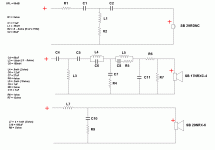 xo schematic w 29RDNC 88dB.GIF14.5 KB · Views: 43
xo schematic w 29RDNC 88dB.GIF14.5 KB · Views: 43 -
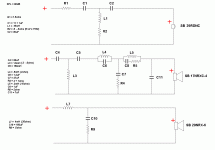 xo schematic w 29RDNC 90dB.GIF13.7 KB · Views: 46
xo schematic w 29RDNC 90dB.GIF13.7 KB · Views: 46 -
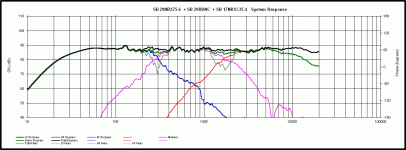 FR summed w 29RDNC centered standing 88dB.gif30.2 KB · Views: 37
FR summed w 29RDNC centered standing 88dB.gif30.2 KB · Views: 37 -
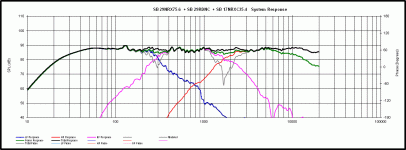 FR summed w 29RDNC centered sitting 88dB.gif30.4 KB · Views: 35
FR summed w 29RDNC centered sitting 88dB.gif30.4 KB · Views: 35 -
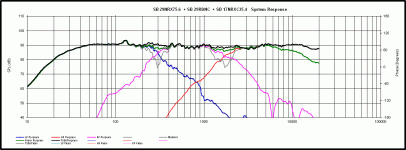 FR summed w 29RDNC centered standing 90dB.gif30.9 KB · Views: 39
FR summed w 29RDNC centered standing 90dB.gif30.9 KB · Views: 39 -
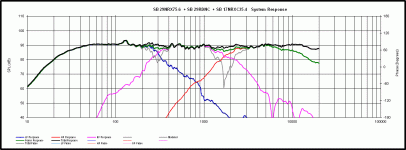 FR summed w 29RDNC centered sitting 90dB.gif31.2 KB · Views: 41
FR summed w 29RDNC centered sitting 90dB.gif31.2 KB · Views: 41
[…] The important bits to get right right are the ones
that really matter.
Which here are IMO a wide and even dispersion with
the lobing at the x/o points optimised to the unusual
typical listening axis being used. Of course minimal
lobing is good, manipulating minimal even better.
Careful layout of the drivers can help the broad central.
e.g. for a mid/treble moving the tweeters out from
vertical will tilt up the lobe towards the centre, and
wont really change the general power response.
rgds, sreten.
Hi sreten. Could you elaborate on your suggestion for the driver layout? I’m not sure what you mean by “moving the tweeters out from vertical will tilt up the lobe towards the centre”. What do you think of my suggested driver layout in post #92?
Thanks for all the help, jReave. Your last posts cleared most of my doubts. And great with some suggestions for buying xo components and how to series/parallel them!
By the way, I have to be honest and say that I can’t really let go of the active xo idea. Perhaps a fully active system won’t be cost-effective here, but I’m still considering going active between bass and mid and then keep it passive between mid/treble. I’m thinking about the possibility of using a miniDSP 2x4, and then either add an extra stereo amp for the woofers or get a 4/5 channel power amp to drive the whole thing. I can find good value second-hand amplifiers in the area.
Going this way would of course mean additional cost of a miniDSP (€100) and an extra second-hand amp (€200), but I would save money on xo parts as well as midrange drivers, where I could use the smaller 5” SB15NRXC30-8, which is actually on offer at Falcon Acoustics. In the end I would get a semi-active system for almost the same price as your suggested passive 3-way would cost.
On the plus side the semi-active setup would give me more flexibility with regards to bass/mid xo as well as EQ possibility. Also, the smaller mids would give me more internal volume for the woofers, which wouldn’t hurt. And last but not least the active setup would mean more power, which would be nice as I think my friend’s Cambridge azur 340A SE (2 x 55 into 4 ohm) is a little small for the proposed SB 3-way.
What do you think? If going this way, would you suggest buying another Cambridge amp, e.g. an Azur 640a, which is the big brother of my friend’s current amp and can be found cheap second-hand. Or would it make more sense to sell the Cambridge and buy a multi-channel power amp to run the whole thing? I see an ADCOM GFA-6000 5-channel power amp, which someone is selling cheap here in the Copenhagen area.
By the way, I have to be honest and say that I can’t really let go of the active xo idea. Perhaps a fully active system won’t be cost-effective here, but I’m still considering going active between bass and mid and then keep it passive between mid/treble. I’m thinking about the possibility of using a miniDSP 2x4, and then either add an extra stereo amp for the woofers or get a 4/5 channel power amp to drive the whole thing. I can find good value second-hand amplifiers in the area.
Going this way would of course mean additional cost of a miniDSP (€100) and an extra second-hand amp (€200), but I would save money on xo parts as well as midrange drivers, where I could use the smaller 5” SB15NRXC30-8, which is actually on offer at Falcon Acoustics. In the end I would get a semi-active system for almost the same price as your suggested passive 3-way would cost.
On the plus side the semi-active setup would give me more flexibility with regards to bass/mid xo as well as EQ possibility. Also, the smaller mids would give me more internal volume for the woofers, which wouldn’t hurt. And last but not least the active setup would mean more power, which would be nice as I think my friend’s Cambridge azur 340A SE (2 x 55 into 4 ohm) is a little small for the proposed SB 3-way.
What do you think? If going this way, would you suggest buying another Cambridge amp, e.g. an Azur 640a, which is the big brother of my friend’s current amp and can be found cheap second-hand. Or would it make more sense to sell the Cambridge and buy a multi-channel power amp to run the whole thing? I see an ADCOM GFA-6000 5-channel power amp, which someone is selling cheap here in the Copenhagen area.
I'm getting the impression that, at least occasionally  , your friend is going to want to play these loud. That's a nice savings on both $ and space with the 15NRXC-8, so not a bad idea. That driver will take 50W so that's about 104dB at 1m. Personally I would think that will be your peak output and so include all the headroom you need, but if you wanted to add 3dB of headroom, then you'll need to double the power, so 100W. For the woofer to hit 104dB, it'll need about 70W so you'll need 140W for the same 3dB of headroom. But notice if your SPL requirements are just 3dB lower, so 101dB, 3dB of headroom only requires half the power.
, your friend is going to want to play these loud. That's a nice savings on both $ and space with the 15NRXC-8, so not a bad idea. That driver will take 50W so that's about 104dB at 1m. Personally I would think that will be your peak output and so include all the headroom you need, but if you wanted to add 3dB of headroom, then you'll need to double the power, so 100W. For the woofer to hit 104dB, it'll need about 70W so you'll need 140W for the same 3dB of headroom. But notice if your SPL requirements are just 3dB lower, so 101dB, 3dB of headroom only requires half the power.
I'm of 2 opinions here. Frequent exposure to SPL's that loud can cause hearing damage. I know this from personal experience. On the other hand, having extra power in reserve doesn't hurt either. Your call.
My experience with amps is limited. I've had great success with an expensive and high powered Denon AVR and a smaller Marantz. Adcom and Cambridge are good names - that's all I know.
I'll just sort of repeat this as well. If your friend thinks the speakers will only ever be placed inside other cabinets, then you can actually get away with thinner walls for all but the front baffles. Do the calculations - you are going to be really surprised by how much volume you gain going 4mm thinner all the way around. And a bigger Vb means a shorter port too. Just a thought.
I'm of 2 opinions here. Frequent exposure to SPL's that loud can cause hearing damage. I know this from personal experience. On the other hand, having extra power in reserve doesn't hurt either. Your call.
My experience with amps is limited. I've had great success with an expensive and high powered Denon AVR and a smaller Marantz. Adcom and Cambridge are good names - that's all I know.
I'll just sort of repeat this as well. If your friend thinks the speakers will only ever be placed inside other cabinets, then you can actually get away with thinner walls for all but the front baffles. Do the calculations - you are going to be really surprised by how much volume you gain going 4mm thinner all the way around. And a bigger Vb means a shorter port too. Just a thought.
Yes, you’re right. My friend would like to be able to crank up the volume occasionally, but we’re not talking about frequent exposure to high SPL.
Okay, but I think that I will go for the partially active setup then, and get either another stereo amp or a new multi-channel. So the drivers will be:
Woofer: 10" SB29NRX75-6
Mid: 5" SB15NRXC30-8
Tweeter: SB29RDNC-C000-4
The TM would actually be the same as Jeff B’s Piccolo, which I have already built. Would his xo be a good starting point for this speaker? I guess that it needs to be changed due to the difference in baffle size as well as off-axis listening position. What would you recommend?
I have made a new SketchUp drawing with updated measurements (the bookshelf has changed slightly since the beginning of this thread). The drawing is based on your suggestion to make the walls thinner since they will have support from the bookshelf wall. The cabinet is now made of 12mm MDF for walls, bracing, and mid enclosure. I can have all the panels for two speakers cut from one sheet, except the baffles which will be 25mm. This give me the following volume:
Volume: 67 L
Midrange: -4.2 L (3.0 L internal)
Bracing: -1.5 L
Ports: -2.0 L
Woofer: -2.0 L
Vb: 57.3 L
I could also change to 16mm for a stronger cabinet with less Vb. What do you think?
Okay, but I think that I will go for the partially active setup then, and get either another stereo amp or a new multi-channel. So the drivers will be:
Woofer: 10" SB29NRX75-6
Mid: 5" SB15NRXC30-8
Tweeter: SB29RDNC-C000-4
The TM would actually be the same as Jeff B’s Piccolo, which I have already built. Would his xo be a good starting point for this speaker? I guess that it needs to be changed due to the difference in baffle size as well as off-axis listening position. What would you recommend?
I have made a new SketchUp drawing with updated measurements (the bookshelf has changed slightly since the beginning of this thread). The drawing is based on your suggestion to make the walls thinner since they will have support from the bookshelf wall. The cabinet is now made of 12mm MDF for walls, bracing, and mid enclosure. I can have all the panels for two speakers cut from one sheet, except the baffles which will be 25mm. This give me the following volume:
Volume: 67 L
Midrange: -4.2 L (3.0 L internal)
Bracing: -1.5 L
Ports: -2.0 L
Woofer: -2.0 L
Vb: 57.3 L
I could also change to 16mm for a stronger cabinet with less Vb. What do you think?
Attachments
The problem is that the layout means you will be listening at approaching 30 degrees off axis where the high frequency SPL is low. As I mentioned earlier, a solution to this is to use a waveguide. The easiest one to use that I am aware of is the SEAS DXT. Compare the output at 30 degress with the tweeters you are currently considering. In addition you get reduced distortion and a clean directivity match with the midrange which becomes more important as the midrange gets larger. An example of how to use the DXT is given here. The example has a less than ideal sensitivity. A more sensitive midrange will need the crossover adjusting and a smaller midrange should cross higher.Could you elaborate on your suggestion for the driver layout? I’m not sure what you mean by “moving the tweeters out from vertical will tilt up the lobe towards the centre”.
Another thing I tried to get across earlier and failed concerned maximum SPL. A speaker with a maximum SPL of 100dB in anechoic conditions would be able to play at the dining table 8m away (-18dB) at a maximum average level (-20dB) of 62dB. The standard/reference listening level is around 80-85dB average where the music is tonally balanced (quieter than this and the highs and lows are missing). Concert and party levels are significantly higher. Thankfully the reflections in the room help the situation by raising the perceived average SPL unless you sit close to the speakers at a desk. In addition serious listening is likely to be done at more like 4m away (-12dB). Maximum SPL, like maximum amplifier power, is all about cleanly handling transients with clean average listening levels being a lot lower.
Yet another thing I tried to get across without much success was the level of the bass boost. Consider the figure in post #9 here. Relative to a speaker designed for use out in the room like the one shown your speaker will have:
(1) on wall bass boost of 6dB like the one shown although the suckout is likely to be less strong because of the floor and partly filled neighbouring bookshelves and the frequency a bit lower because of a bigger cabinet.
(2) on floor bass boost of 6dB which given the close proximity should be fairly smooth.
(3) near side wall bass boost which is likely to be less smooth. Compare different path lengths and wavelengths for likely location of wiggles.
On top of this you will also have the effects of room modes. This is indicating a significantly geater bass boost than jReave who in turn is suggesting a larger bass boost than sreten. You can either choose who to believe, simulate it yourself using an appropriate tool or choose hardware that will allow you to adjust the design by more than 10dB and take a corresponding hit in overall speaker performance.
Concerning the cabinet. Ending the slot against back wall will increase the constriction of the slug of air as it moves back and forth and change the tuning. It is probably better to end the slot in more space and have the opportunity to change the length a bit. You might want to consider side slots like this if you are pushed for height with a big midrange. Is your midrange cabinet going to foul on the maget? Generally you want avoid restricting the area seen by the high frequencies radiating away from the rear of the cone or else they will reflect back. Chamfering away some of the baffle is also a common thing to do to help with this. If you are pushed for space within the baffle then something like this will match the SB in a significantly smaller volume and with a lower voice coil inductance. It is more expensive though.
- Status
- This old topic is closed. If you want to reopen this topic, contact a moderator using the "Report Post" button.
- Home
- Loudspeakers
- Multi-Way
- 3-way for bookshelf (in-wall)
